 We love fresh trout. This is an easy and delicious recipe for a weeknight. You can use either slivered almonds (shown here) or sliced almonds. The slivered ones retain more crunch and less of the buttery goodness, so it's easy to choose.
We love fresh trout. This is an easy and delicious recipe for a weeknight. You can use either slivered almonds (shown here) or sliced almonds. The slivered ones retain more crunch and less of the buttery goodness, so it's easy to choose.
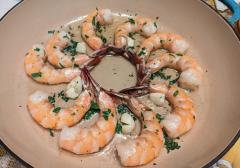 This recipe for gamberoni al forno (baked jumbo shrimp) is simple and easily expandable. It has just four ingredients, three of which you probably have in the kitchen most days.
This recipe for gamberoni al forno (baked jumbo shrimp) is simple and easily expandable. It has just four ingredients, three of which you probably have in the kitchen most days.
The simple word shrimp is astoundingly confusing when you try to get into details relevant to the kitchen. Please see Shrimp.
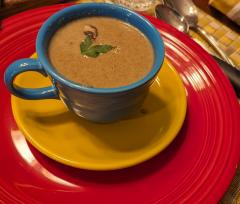 This is a tasty soup with few ingredients. The veloute technique is easy, just like making a roux-thickened sauce, so if you find that easy then the whole thing is easy.
This is a tasty soup with few ingredients. The veloute technique is easy, just like making a roux-thickened sauce, so if you find that easy then the whole thing is easy.
The French name for this fall and winter warmer is Potage Veloute aux Champignons. The French classify soups in three broad ways: a potage is a thick soup, a soupe is a thin soup with veggies and whatever else in it, and a consomme is a perfectly translucent broth clarified from an excellent stock. This potage can be made with chicken, beef, ham, or vegetable stock, or if you use dried mushrooms then the strained mushroom soaking liquid can be used for some or all of the stock.
For the dinner at which this was served, it was followed by the fish course and one of our diners is vegetarian, so I made a veggie stock from the trimmings of the vegetable course and added the mushroom soaking liquid from some dried wild mushrooms.
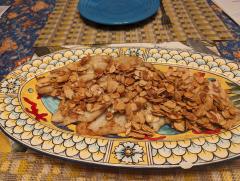 This is a simple and delicious preparation for fillets of sole or trout that is easy to make on a weeknight. You toast the sliced almonds in butter, and then pan-fry the fish in butter and dress it with the almonds.
This is a simple and delicious preparation for fillets of sole or trout that is easy to make on a weeknight. You toast the sliced almonds in butter, and then pan-fry the fish in butter and dress it with the almonds.
I did the one in the photo with a full cup of almonds because Lorna likes it that way!
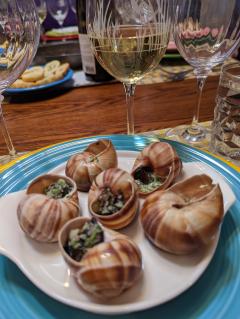 Here's the classic French escargot, plump vineyard snails drowning in herbed garlic butter. Old recipes are pretty slow and labor intensive, starting with purging the snails by feeding them cornmeal or something similar, then boiling and cleaning them before finally replacing them in their shells and broiling them with "snail butter".
Here's the classic French escargot, plump vineyard snails drowning in herbed garlic butter. Old recipes are pretty slow and labor intensive, starting with purging the snails by feeding them cornmeal or something similar, then boiling and cleaning them before finally replacing them in their shells and broiling them with "snail butter".
I did not pick plump snails from my neighborhood vineyard! I bought the snails cleaned and precooked in a can, and I bought the snail shells on Amazon.
You see them here served in snail shells on a snail dish. I bought the dishes on Amazon for pretty small money, and special snail tongs for picking up the hot snail shells without spilling the yummy butter.
If you have the snail dishes, then you can do without the shells and the tongs and simply serve them in the wells of the dish with the melted snail butter in the wells, but this is a more eyecatching way to serve them. Please see the notes below.
This recipe is for 18 snails, because that what comes in a small can. The snail dishes that I found hold seven, but on the other hand not all of my diners was ready for a full dish of these garlicky mollusks.
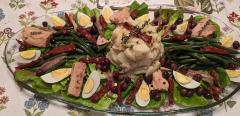 We have new neighbors, a fine friendly couple named Mike & Maryann. We invited them over for a Provencal Feast on Sunday, December 17th, 2023. I selected Provencal food because it's different from what we usually see in Plymouth, it's popular with many people, and it was a chance to bring a splash of sunny southern France into our gray December day.
We have new neighbors, a fine friendly couple named Mike & Maryann. We invited them over for a Provencal Feast on Sunday, December 17th, 2023. I selected Provencal food because it's different from what we usually see in Plymouth, it's popular with many people, and it was a chance to bring a splash of sunny southern France into our gray December day.
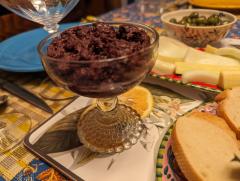 We normally start with an Aperitif in the Living Room, but the Christmas tree made that room too crowded so everything was in the dining room. For the aperitif, we opened with Absinthe cocktails and chilled Lillet Blanc, and:
We normally start with an Aperitif in the Living Room, but the Christmas tree made that room too crowded so everything was in the dining room. For the aperitif, we opened with Absinthe cocktails and chilled Lillet Blanc, and:
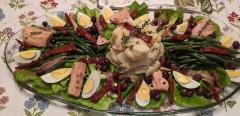 Here's a beautiful and substantial salad suitable as a main course for a light lunch or on a picnic. It is full of the sunny Mediterranean flavors of southern France: olives, tuna, anchovies, tuna, tomatoes. I made this one in December for a special feast, so I used sun-dried tomatoes instead of "fresh" ones, and it was great.
Here's a beautiful and substantial salad suitable as a main course for a light lunch or on a picnic. It is full of the sunny Mediterranean flavors of southern France: olives, tuna, anchovies, tuna, tomatoes. I made this one in December for a special feast, so I used sun-dried tomatoes instead of "fresh" ones, and it was great.
The foundation of this is a bed of nice green lettuce dressed with Sauce Vinaigrette and topped with French Potato Salad and cold blanched green beans, then dressed with anchovies, hard-cooked eggs, and everything else.
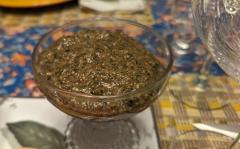 This exquisite anchovy-based spread is wonderful on crudites or on toasted baguette rounds. It's the kind of recipe that leaves your guests wondering what all the flavors are. This recipe is said to come from the occultist, folklorist, and "celebrated gastronome" Count Austin de Croze (1866-1937), by way of Martha's Vineyard restaurateur, cookbook author, and cycling enthusiast Sarah Leah Chase's Pedaling Through Provence.
This exquisite anchovy-based spread is wonderful on crudites or on toasted baguette rounds. It's the kind of recipe that leaves your guests wondering what all the flavors are. This recipe is said to come from the occultist, folklorist, and "celebrated gastronome" Count Austin de Croze (1866-1937), by way of Martha's Vineyard restaurateur, cookbook author, and cycling enthusiast Sarah Leah Chase's Pedaling Through Provence.
 Here's a tasty salty-sweet spread from Provence that is easy to make in quantity. Use good olives, not the woody canned variety. If you cannot get the figs, 1/3 cup of fig jam is an acceptable substitute. Serve this on crackers or on toasted baguette rounds, or with crudites.
Here's a tasty salty-sweet spread from Provence that is easy to make in quantity. Use good olives, not the woody canned variety. If you cannot get the figs, 1/3 cup of fig jam is an acceptable substitute. Serve this on crackers or on toasted baguette rounds, or with crudites.
 Here's another great winter warmer, especially for those first frosty nights in November when you still have fresh apples. It's just bourbon mixed with applesauce and hot water, but it's delicious!
Here's another great winter warmer, especially for those first frosty nights in November when you still have fresh apples. It's just bourbon mixed with applesauce and hot water, but it's delicious!
This recipe is for two drinks, and it includes baking one apple and making fresh applesauce from it. You can save half an hour by using good-quality store-bought applesauce: use a heaping tablespoon of that for a single drink.
This would look nice with a cinnamon stick garnish if you can get three or four-inch cinnamon sticks.
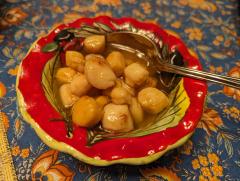 There's bay scallops and there's Cape Cod or Nantucket bay scallops. You can get great quantities of Chinese farmed bay scallops for an economical price, but their flavor is decidedly ho-hum. The local ones are sweet and wonderful and every bit worth the price, even if you get just a quarter-pound to put over rice or pasta. This recipe works well for that, or as a decadent appetizer.
There's bay scallops and there's Cape Cod or Nantucket bay scallops. You can get great quantities of Chinese farmed bay scallops for an economical price, but their flavor is decidedly ho-hum. The local ones are sweet and wonderful and every bit worth the price, even if you get just a quarter-pound to put over rice or pasta. This recipe works well for that, or as a decadent appetizer.
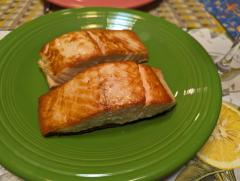 This is Lorna's favorite salmon, very plain and simple. You can have it on the table in 20 minutes!
This is Lorna's favorite salmon, very plain and simple. You can have it on the table in 20 minutes!
 This old chestnut used to be enormously popular, and many homes had their own special Tom and Jerry bowls and mugs to bring out at Christmastime.
This old chestnut used to be enormously popular, and many homes had their own special Tom and Jerry bowls and mugs to bring out at Christmastime.
A Tom and Jerry bowl? Where does the bowl come in?
This is a complicated hot drink, requiring preparation and equipment, but it's worth it. You start by boiling a kettle of water and warming some glasses. Then you have to whip up some egg whites, and the yolks with sugar and spices, then you mix that part together in your Tom and Jerry bowl and put a spoonful into each warm glass, and then you can add the brandy and the rum (both), and finally the hot water and a sprinkle of nutmeg.
Well, that's a lot, but most of it is in mixing up the Tom and Jerry batter, which you can do ahead of time and have it ready and waiting in your Tom and Jerry bowl for when your guests arrive. You can see that this would be a lot of work to make a single drink, and no more work to mix it up for six people or a whole party.
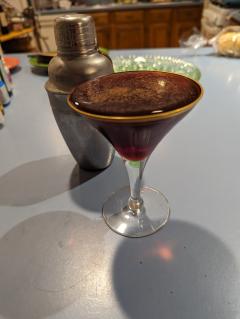 This is another of those fine forgotten libations from before the Civil War that deserves to be revisited, especially during the holidays. I think I have counted a half-dozen sangarees mentioned in the short stories of Nathaniel Hawthorne!
This is another of those fine forgotten libations from before the Civil War that deserves to be revisited, especially during the holidays. I think I have counted a half-dozen sangarees mentioned in the short stories of Nathaniel Hawthorne!
You can make a whiskey or rum or gin sangaree just by substituting the base spirit, but I think that brandy or cognac go best with the port.
A sangaree is just some spirit sweetened with a little sugar and mixed 2:1 with port. It has no lemon or lime juice and no bitters, so it's on the sweet side, but it's a fine treat after Thanksgiving dinner or at Christmastime!
 On Sunday, 12 March 2023, our friends Bryan and Bridget joined us for a Tour of France Dinner. I called it a Tour of France because it has seven courses, each highlighting a different region of France. The regions of France have long histories of developing their own foodways and intense attention to terroir, thus I also served wines from the same regions as the food in each course. This meant that I served a lot of wine! We were sensible and tasted each of the eight wines but we did not drink all of any of them. (Well, maybe we finished just a few of them!)
On Sunday, 12 March 2023, our friends Bryan and Bridget joined us for a Tour of France Dinner. I called it a Tour of France because it has seven courses, each highlighting a different region of France. The regions of France have long histories of developing their own foodways and intense attention to terroir, thus I also served wines from the same regions as the food in each course. This meant that I served a lot of wine! We were sensible and tasted each of the eight wines but we did not drink all of any of them. (Well, maybe we finished just a few of them!)
